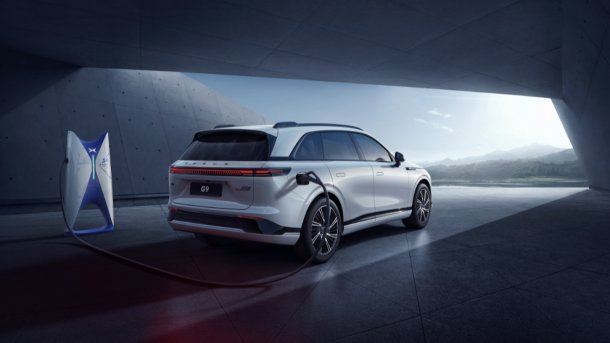Chinese automaker Xpeng and its wonder weapon: the next generation
Xpeng is considered a pioneer in autonomous driving and charging technology. They see their new SUV G9 as the next big step in electric cars.

Xpeng has high hopes for the new flagship G9.
(Bild: Xpeng)
- Christian Domke Seidel
(Hier finden Sie die deutsche Version des Beitrags)
Episode five of a ten-part series in which heise/Autos looks at the Chinese car market. There, Chinese electric car producers - some of them strongly supported by the so-called Communist Party - are just warming up in order to soon roll up the domestic and international markets with a lot of momentum and a colorful bouquet of state-of-the-art cars. This is likely to have consequences for German car manufacturers, whose largest single global market has been China for several years.
On the one hand, this will foreseeably change the picture on German and European roads, but it will also have repercussions for German producers and their sales in China, the world's largest single market.
The best is yet to come: If Xpeng has its way, it will be an SUV called G9. For the manufacturer, the vehicle marks something like a new generation of electric cars. It is supposed to combine everything that makes the brand strong and become the new gold standard of electric cars, also in Europe. Xpeng has long since ventured westward.
The G9 is 4.89 meters long and comes with either 230 with rear-wheel drive or 405 kW with all-wheel drive. The car costs between 42,000 and 64,000 euros in China. The car has been available for order there since the beginning of September 2022 - and within the first 24 hours 23,000 customers did so. By comparison, Tesla delivered 172,418 Model Y cars to customers in the People's Republic in the first nine months of the year.
Xpeng G9: fast charging and autonomous driving
The G9 is said to be capable of two things in particular: fast charging and autonomous driving. Thanks to the 800-volt on-board power supply, enough electricity for around 200 kilometers reaches the battery within five minutes under favorable conditions. Xpeng markets the vehicle as "the world's fastest-charging mass-produced EV." Those with a little more time to charge can achieve a total range of 702 kilometers in the Chinese CLTC cycle. CATL's battery is also said to be particularly easy to recycle. Xpeng follows the same tactics as Tesla, so in China cars can be charged for free at the manufacturer's charging stations and those of its cooperation partners. Xpeng maintains about 1200 of its own charging stations and has contracts with partners for about 200,000 more.
(Bild: Xpeng)
Point two is autonomous driving. Xpeng will launch an autonomous cab service in Guangzhou in 2023. Other cities are to follow, all with said G9. Robot cabs are considered a big business field of the future in China. Xpeng has the advantage of being able to use the series G9, while other manufacturers have yet to upgrade their vehicles with the corresponding technology. In China, the G9 is considered one of the production cars with the most advanced AI for autonomous driving.
Xpeng on course for Europe
So it's no wonder that Xpeng is hoping for a boost from the G9. In the first nine months of 2022, the brand has a total of 98,000 vehicles. Around 125,000 to 130,000 are expected for the year as a whole. That would almost double sales figures. Xpeng is already present on the European market. In Norway, Sweden, Denmark and Holland, there are centrally located showrooms that resemble living rooms.
For example, the Danish Xpeng store is located in the center of Copenhagen, directly opposite the Tivoli. Just a three-minute walk from the central station. Everything is clad in wood, espresso is served, and anyone who wants to take a test drive in the P7 sedan has to wait a maximum of 15 minutes. In the future, the brand wants to sell half of all its vehicles outside China. However, the manufacturer does not specify a year for this ambitious goal.
(Bild: Xpeng)
With the current model range, the goal is only a pious hope anyway. The P7 is a very good electric car. It is unspectacular in the best sense of the word. The choice of materials is first-class, the workmanship is premium. However, it is only a sedan. A vehicle class that lost importance in the SUV boom and only plays a role at all because of company cars. At least the Xpeng P7 (around 56,000 euros) is cheaper there than a comparable Audi A4 because of the high taxes on combustion engines in Denmark.
Xpeng has the necessary change
Money for Xpeng's expansion plans is available. The IPO in the summer of 2020 raised $1.5 billion, and an additional share issue raised another $2.5 billion. Because money was cheap on the financial markets at the time, the brand also raised extremely cheap loans of $2.5 billion from the Bank of China, China Construction Bank and Agricultural Bank of China. In addition, three large and prominent companies, Alibaba, Foxconn and Xiaomi, are involved, as well as rather discreet financiers from the USA, Qatar and Abu Dhabi.
Given the successes in charging and autonomous driving, the money seems to have been put to good use. So successful, in fact, that Elon Musk accused the Chinese competitor of stealing his technology. For autonomous driving, XPeng relies on a combination of high-resolution cameras, ultrasonic and lidar sensors. The latter made Tesla wonder, even though the technology is now not uncommon in the automotive sector. The accusations remained, but Tesla was unable to provide any evidence.
(fpi)